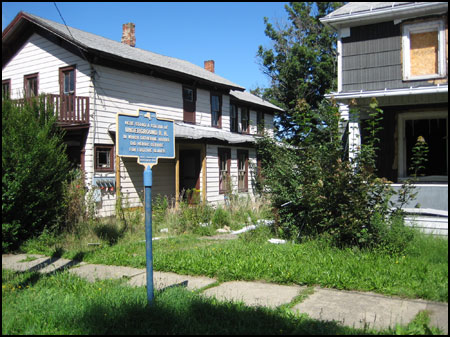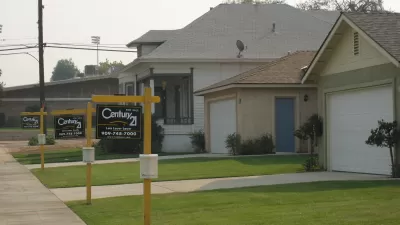The foreclosure crisis spreading across America has burdened cities and neighborhoods with value-draining vacancies and abandoned properties. To counteract the economic havoc they've caused, planners and policymakers must focus on restoring confidence in the market, according to neighborhood planning consultants Charles Buki and Elizabeth Humphrey Schilling.
Like Tolstoy's unhappy families, every weak market is weak in its own way. Communities need -- and deserve -- surgically precise interventions based on real data about their exact stage of decline and the true source of their weakness. Interventions based on averages and broad brush approaches not only fail, but often drive these markets further into decline. Interventions that do not consider the psychology of risk are also suspect, because they ignore the motivation behind homeowners' choices.
In data and experience our neighborhood planning practice has gathered over the years in markets across the spectrum from nearly broken to merely behind the curve, the most important indicator of market strength is market confidence. Property owners derive confidence from signals they receive. Cues from other property conditions alert a property owner to how others are reading the market and shaping supply. Cues from shifts in the market (who is moving in and out) inform a property owner about the nature of demand.

Lacking confidence that the market is getting better, or at least stable, owners conclude any subsequent investment may be an over-investment. The result: a pullback and the denial of investments both essential and, paradoxically, affordable. The irony is that in weak markets these behaviors make property owners their own worst enemies.
Low confidence is not solely the result of years of economic shocks, either. It is causal. Some markets have too much confidence, some have very little left in their reservoir after years of decline. Many more are somewhere in between. In these precarious markets, restoring and leveraging confidence must be the overall aim of any plan to establish stability and strength.
This first in a pair of commentaries will explain the dynamics of confidence loss in weak markets, and its indispensable but overlooked role in recovery. The second will explore a true market-based approach to failing neighborhoods suggested by these dynamics: monetizing confidence and persuading residents to invest in their own turn-around.
Stages of Decline
There are four indications of weakness in the earliest stage of market decline: Falling prices and sagging other sales data such as time on market, price to list ratio, and population loss; quickened retail turnover; and limited and falling permitting activity. During this stage, the primary inputs for decline are either job loss or superior competition. The distinction is important because most small markets focus their energy on an anemic jobs condition and miss important housing market issues that need attention. Which of these is at work becomes clear upon examination of historic sales data in the context of a thorough property conditions analysis.
The second stage of decline is the tipping point for market confidence. Reduced levels of owner investment in their homes, millage creep, and retail vacancy all emerge during this stage, when communities have already failed at their number one responsibility: retaining strong households. The loss of families with the resources to leave has profound implications for those who remain in terms of how wise it is for them to invest. When strong families take their strong incomes with them, commercial real estate begins to show the effects of dropoffs in spending. Communities look tired. This is the stage where service costs outstrip revenue, and tax rates become germane indicators of the extent to which a market is in trouble. A sad irony is that frustration with "rising taxes" often results in a perverse failure by owners to acknowledge that the key culprit driving tax increases is property investment decreases.
This second stage is the most delicate because community memory still sees overall market strength. Distressed blocks appear (wrongly) to be ideal places to address affordable housing problems -- which are, after all, regional -- and the region is all too happy to let these sagging markets absorb more than their fair share of struggling families, further degrading recovery potential with too much subsidy on blocks with too little equity. This is the make-or-break time for successful interventions. The costs of recovery now pale in comparison with the expense of intervening years later -- when neighborhoods are more completely distressed; however, perceived community strength makes it hard to find the political will to invest in localized recovery.
In the final stage, after persistent population loss and falling prices, deferred maintenance is no longer sporadic but has taken hold throughout. The sagging roof and leaky faucet have become the new norm. Vacancy turns into abandonment. Affordable housing misguidedly developed on the wrong blocks has failed to generate confidence in the market. Retail has been degraded significantly, and pocket blight is no longer a threat but a prevailing reality. In these latter stages of decline, a city whose residents once would have enjoyed a positive rate of return on investments in their homes now confronts a situation completely reversed. Because this decline is often marked by ups and downs instead of just a straight line collapse, and because it takes decades, successive generations get accustomed to the slow erosion of high standards of maintenance. They get used to both the sagging roof and leaky faucet, and the palliative if flawed assumption that the task at hand is to make the market more affordable to low-income families. Meanwhile, population loss continues, prices keep falling, and properties fall further into disrepair.
|
Stage of Decline |
Indicators |
What it Says |
|
First |
|
|
|
Second |
|
|
|
Third |
|
|
Implications for Recovery
Breaking down the decline of a market into specific stages highlights two crucial facts about how this process happens.
First, it reminds us that it takes years for a market to fail. No market is static. Neighborhoods must continually compete to retain their strong households, and installing new buildings cannot in a weak market address competitiveness on its own.
Second, it reminds us that no market is monochromatic. Any policy or other market intervention decision based on city-wide or even neighborhood averages runs the risk of putting scarce dollars on the wrong block. When married to a failure to see a weak market as a demand problem to be solved, the supply-oriented remedy will always seek the lowest cost land possible. Invariably these are the least valuable sites, which are those in greatest distress. More affordable housing on these sites is the very definition of counterproductive.
What we've found in property-by-property analyses in a number of cities confirms what real estate brokers, appraisers and community developers already know - the location and quality of each poorly-maintained house impacts the values of other homes on a block. Really knowing exactly what to do on each block to move the market is essential.
Jamestown, New York is a weak market city addressing challenges similar to those in other western and upstate NY communities, as well as those in western Pennsylvania and parts of Ohio and Michigan. Currently at about 30,000 people, the city has lost population fairly steadily since 1940, though surrounding Chautauqua County still draws new residents. In its struggle to get "right-sized" as a market, Jamestown's circumstances are valuable teaching tools.
Our analysis of individual building conditions and assessor's data in Jamestown found that proximity to a poor-quality building reduced high-quality properties' average sales price by 33%, and fair-quality properties average sales price by 39%. Furthermore, poor quality structures exert a far more significant drag on middle quality blocks than on severely distressed ones, and recovering a problem property on a middle quality block pays a far higher dividend than reclaiming a problem property on a problem block. The implication is that removing a block's poor-quality properties, particularly when there are only a few, can profoundly increase the value of all surrounding properties, but only if local leadership is willing to make the hard choice between spending resources to repair confidence or spending resources to reclaim abandoned or distressed property without solving for why the property was abandoned in the first place.
This point is essential in identifying where sequentially strategic interventions will be most effective in righting a failing market. It also highlights the political difficulty of committing to an effective action plan.
Local governments rightly feel compelled to address their market woes. Rarely having their own resources, they look to state and federal programs for assistance, but state and federal programs come with rules that prevent tailored solutions. In fact, most of them promote supply increases on the very blocks least likely to attract buyers of choice. While these approaches are often suitable in strong markets, in weak markets they are likely to further undermine confidence and drive decline.
Furthermore, local politics almost never reward hard choices. What local officials need to address is what they already know anecdotally: even a failed market will still have strong streets and blocks and sections in one part of town, and other blocks elsewhere in various stages of decline.
No one is well served if all blocks are lumped together into the same bucket, though this insight does not alleviate the political risk that must be taken in making these choices. In the case of weak markets, the choices are often all grim. Yet even where good outcomes are easily achievable, few elected officials have the stomach to invest on Lafayette Street intentionally but not Cherry Street, on Summers but not Myrtle, on 34th Street but not 44th.
Indeed this point becomes more important the deeper into the hole a market falls, as, cruelly, fewer resources have to do more. A failure to think carefully about the stages of growth and decline on each block in a city will fail to get at the structural essence of the problem. The structural problem in weak markets is too little confidence that it makes sense to stay.
This is the problem that causes rational families to flee Michigan for stronger economies in Virginia, to leave the inner city of Baltimore for Reisterstown, MD, to leave Belmont Avenue in Fresno for anywhere better. Behind every choice to move is the presence or absence of confidence combined with the wherewithal to do something about it.
The structural problem to remedy is not the existence of abandoned housing. The decision to abandon a property is a symptom of the loss of confidence. And while abandonment certainly affects confidence among surrounding homeowners, the most important question to answer is not "how do we deal with abandoned properties?" but "what is the most cost-effective way to restore market confidence, and how do abandoned properties fit into that picture?"
The structural problem to remedy is not the low incomes that many working families find too slim to obtain quality housing they can afford. This is a distinct problem that may need to be addressed at the same time, but should not be confused with the work of rebuilding confidence.
Under such dire conditions as those so many Rust Belt markets are facing, one could easily be led to conclude that in such weakened places, confidence is unrecoverable. And though there are markets in the United States such as Camden and Gary where this may indeed be true, important data suggests otherwise.
Data from across Indiana, Illinois, Ohio, Michigan, Pennsylvania, and New York provide quantifiable, justifiable reason for concluding market stability is possible. Interestingly, it is in a different data point altogether where we have recently begun to conclude that very weak market cities can still be recovered. And it is in this data where the structural problem that needs attention is revealed: the lack of confidence in the market.
Charles Buki and Elizabeth Humphrey Schilling work at czb, a neighborhood planning practice based in Alexandria, VA.

Planetizen Federal Action Tracker
A weekly monitor of how Trump’s orders and actions are impacting planners and planning in America.

Chicago’s Ghost Rails
Just beneath the surface of the modern city lie the remnants of its expansive early 20th-century streetcar system.

San Antonio and Austin are Fusing Into one Massive Megaregion
The region spanning the two central Texas cities is growing fast, posing challenges for local infrastructure and water supplies.

Since Zion's Shuttles Went Electric “The Smog is Gone”
Visitors to Zion National Park can enjoy the canyon via the nation’s first fully electric park shuttle system.

Trump Distributing DOT Safety Funds at 1/10 Rate of Biden
Funds for Safe Streets and other transportation safety and equity programs are being held up by administrative reviews and conflicts with the Trump administration’s priorities.

German Cities Subsidize Taxis for Women Amid Wave of Violence
Free or low-cost taxi rides can help women navigate cities more safely, but critics say the programs don't address the root causes of violence against women.
Urban Design for Planners 1: Software Tools
This six-course series explores essential urban design concepts using open source software and equips planners with the tools they need to participate fully in the urban design process.
Planning for Universal Design
Learn the tools for implementing Universal Design in planning regulations.
planning NEXT
Appalachian Highlands Housing Partners
Mpact (founded as Rail~Volution)
City of Camden Redevelopment Agency
City of Astoria
City of Portland
City of Laramie





























